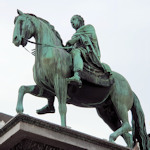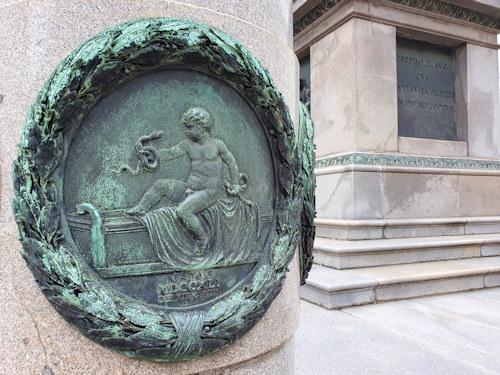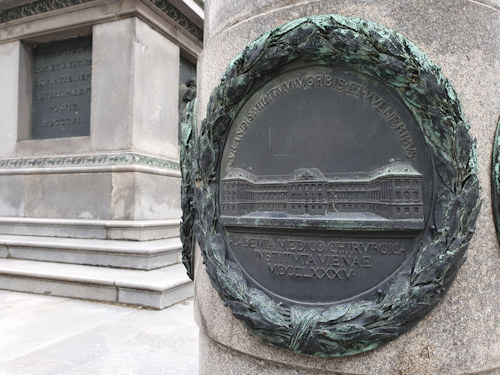
The Habsburgs were not averse to drawing on Roman imagery to enhance their imperial image. One such example is the equestrian statue of Emperor Joseph II in Vienna’s centre.
- Mimics the Roman statue of Marcus Aurelius
- Unveiled in 1807
- Crafted by Franz Anton Zauner at the request of Emperor Franz II/I
- Numerous reliefs commemorate significant achievements and moments in Joseph’s life
- See also:
One man and his horse

(The monument with the National Library and Hofburg Redoutensäle behind)
Drop into Rome’s Museo del Palazzo dei Conservatori and you’ll spot a bronze masterpiece constructed some 2000 years ago: the huge statue of Emperor Marcus Aurelius atop his horse.
The classical sculpture served as inspiration for a similar statue on Josefsplatz square at the edge of Vienna’s Hofburg palace complex.

(The Marcus Aurelius pose)
The Viennese statue sees Emperor Joseph II (1741-1790) and his horse mimicking the posture of their spiritual Roman predecessors and forms the centrepiece of a giant monument to one of the more progressive Habsburg monarchs.
Emperor Franz II/I (Joseph’s nephew) commissioned the work from sculptor Franz Anton Zauner, with the unveiling taking place in 1807.
(Zauner also contributed the caryatids over the road from the statue at the entrance to Palais Pallavicini.)

(Portrait of Joseph II by Heinrich Friedrich Füger from around 1785; Wien Museum Inv.-Nr. 132646; excerpt reproduced under the terms of the CC BY 4.0 license; photo by Birgit and Peter Kainz)
The plinth below the horse features two reliefs symbolising Joseph’s role in promoting trade and agriculture. The remaining two sides bear Latin inscriptions: one honours Joseph as a ruler who worked in the interests of his people, the other honours Franz as the monument’s initiator.
Numerous reliefs in medallion form also cover the surrounding columns. These highlight, for example, significant moments in Joseph’s life, such as his birth and marriage.

(Medallion commemorating Joseph’s birth in 1741)

(Medallion commemorating the opening of the surgical academy)
Other reliefs also reflect the achievements of Joseph’s reign, such as his founding of the Josephinian Military Academy of Surgery (opened in 1785) or the Patent of Toleration in support of religious freedom.
The makers had a fair few achievements to choose from, as Joseph proved a remarkably enlightened and progressive leader (for the times).
Despite looking down on over 200 years of Austrian history, however, the monument’s moment of greatest fame perhaps came through Hollywood.

(The square in front of the Imperial court library with the statue of Joseph II, published in 1808 by Artaria & Co. Verlag using artwork by Carl Schütz; Wien Museum Inv.-Nr. 6425; excerpt reproduced with permission under the terms of the CC0 licence)
In the acclaimed movie The Third Man, the steps facing the road proved the alleged location of Harry Lime’s death following a road accident.
The square, Palais Pallavicini and the monument itself feature in various scenes from the film.
How to get to the monument
Follow the travel tips at the bottom of the Josefsplatz article. You’ll spot the monument easily once there and pass it if you follow my suggested walking tour route through the city centre.
Joseph’s statue is not even close to being the most historical sight on the square. You have, for example, the entrance to the Baroque state hall of the National Library on one side, as well as the Augustinerkirche church, which dates back to the 1300s.
Address: Josefsplatz, 1010 Vienna